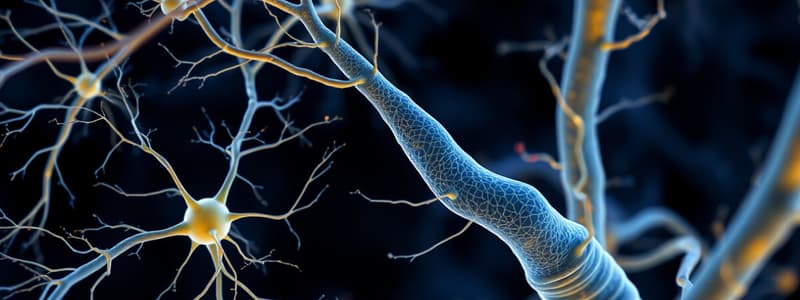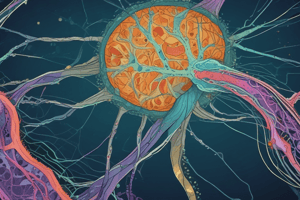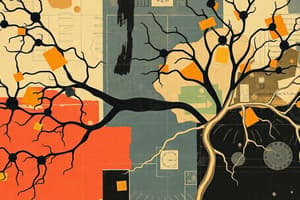Podcast
Questions and Answers
What defines a unipolar neuron?
What defines a unipolar neuron?
- Having one axon and multiple dendrites
- Having a single neurite connected to the soma (correct)
- Having one dendrite connected to the soma
- Having multiple axons and one dendrite
Which shape describes a pyramidal neuron?
Which shape describes a pyramidal neuron?
- Triangular (correct)
- Cuboidal
- Cylindrical
- Starlike
What role do dendritic spines play in neurons?
What role do dendritic spines play in neurons?
- They affect the transport of neurotransmitters
- They serve as the primary output signal of the neuron
- They prevent neurotransmitter release
- They are involved in learning and memory (correct)
How are multipolar neurons primarily distinguished?
How are multipolar neurons primarily distinguished?
What happens to dendritic trees over time?
What happens to dendritic trees over time?
What is the main effect of the influx of Na+ ions on the membrane potential during depolarization?
What is the main effect of the influx of Na+ ions on the membrane potential during depolarization?
What occurs during the hyperpolarization phase after K+ ions leave the neuron?
What occurs during the hyperpolarization phase after K+ ions leave the neuron?
What happens to the voltage-gated Na+ channels during the first part of the axon when the membrane potential is positive?
What happens to the voltage-gated Na+ channels during the first part of the axon when the membrane potential is positive?
Which ion primarily contributes to the depolarization of the membrane?
Which ion primarily contributes to the depolarization of the membrane?
Which ion movement occurs during the repolarization phase of an action potential?
Which ion movement occurs during the repolarization phase of an action potential?
What is the primary function of the sodium-potassium pump?
What is the primary function of the sodium-potassium pump?
How does the sodium-potassium pump restore the electrical potential of the cell?
How does the sodium-potassium pump restore the electrical potential of the cell?
What type of channels open when the cell becomes positively charged?
What type of channels open when the cell becomes positively charged?
Which ion primarily flows into the cell when K+ channels are open at rest?
Which ion primarily flows into the cell when K+ channels are open at rest?
Which statement regarding voltage-gated Na+ ion channels is true?
Which statement regarding voltage-gated Na+ ion channels is true?
What energy source does the sodium-potassium pump require for its function?
What energy source does the sodium-potassium pump require for its function?
What occurs during the communication in the brain when the cell becomes positive?
What occurs during the communication in the brain when the cell becomes positive?
What factor contributes to an axon's speed of transmission?
What factor contributes to an axon's speed of transmission?
When Na+/K+ pumps function effectively, what is the resultant condition of the cell?
When Na+/K+ pumps function effectively, what is the resultant condition of the cell?
During which period is a neuron unable to fire another action potential?
During which period is a neuron unable to fire another action potential?
What occurs during the relative refractory period?
What occurs during the relative refractory period?
What happens to the membrane potential when a neuron is hyperpolarized?
What happens to the membrane potential when a neuron is hyperpolarized?
Which ion channel is primarily involved in repolarization during an action potential?
Which ion channel is primarily involved in repolarization during an action potential?
What is the undershoot in the action potential due to?
What is the undershoot in the action potential due to?
How long does the absolute refractory period last after an action potential?
How long does the absolute refractory period last after an action potential?
What must occur during the refractory period for a neuron to fire again?
What must occur during the refractory period for a neuron to fire again?
What is one of the primary functions of glial cells in the central nervous system?
What is one of the primary functions of glial cells in the central nervous system?
Which type of glial cell is responsible for myelination in the peripheral nervous system?
Which type of glial cell is responsible for myelination in the peripheral nervous system?
How do ions pass through the plasma membrane of a neuron?
How do ions pass through the plasma membrane of a neuron?
What role does the sodium-potassium pump serve in maintaining the resting membrane potential?
What role does the sodium-potassium pump serve in maintaining the resting membrane potential?
What happens to potassium ions at rest compared to sodium ions?
What happens to potassium ions at rest compared to sodium ions?
Which of the following glial cells helps stabilize and synchronize the activity of neurons?
Which of the following glial cells helps stabilize and synchronize the activity of neurons?
Why is the plasma membrane described as impermeable to ions?
Why is the plasma membrane described as impermeable to ions?
What characteristic of the phospholipid bilayer contributes to its selective permeability?
What characteristic of the phospholipid bilayer contributes to its selective permeability?
Flashcards are hidden until you start studying
Study Notes
Neurite Classification
- Neurites include axons and dendrites; one axon and one dendrite equal two neurites.
- Classification based on the number of neurites connected to the soma: unipolar, bipolar, and multipolar.
- Bipolar neurons are relatively common; unipolar dendrites are not found in vertebrates.
Dendritic Classification
- Neurons are classified by the shape of dendrites: stellate (star-shaped) versus pyramidal (triangular).
- Dendrites can be either spinous (having spines) or aspinous (lacking spines).
- Dendritic spines play a crucial role in learning and memory.
- Dendritic trees are dynamic and change through growth or retraction, contributing to neuroadaptation.
- The number of dendrites influences the information the neuron can receive.
Glial Cells
- Types of glial cells include astrocytes, oligodendrocytes, microglia, and Schwann cells.
- Glial cells support neurons both chemically and physically.
- In the central nervous system, glial cells connect multiple neurons, providing stability and synchronizing their activity.
Membrane Potential and Action Potential
- The plasma membrane is a phospholipid bilayer that allows uncharged molecules to pass through but not ions.
- Ions must pass through specific channels for membrane potential regulation.
- The sodium-potassium pump moves 3 Na+ out and 2 K+ in, maintaining the chemical and electrical balance.
- Potassium ions can move freely, influenced by both electrical and chemical gradients.
Ion Channels and Action Potential
- Voltage-gated Na+ channels only open at specific membrane potentials (approximately -50 to +30 mV).
- Voltage-gated K+ channels open when the cell’s internal environment becomes more positive.
- Receptors regulate K+ flow during resting states, while Na+/K+ pumps create depolarization by allowing Na+ influx.
Refractory Periods
- After an action potential, voltage-gated Na+ channels close and K+ channels open, leading to hyperpolarization.
- The thickness and myelination of axons influence conduction speed due to reduced electrical resistance.
- The absolute refractory period lasts approximately 1 ms after an action potential when the neuron cannot fire again.
- The relative refractory period, lasting 2-4 ms post-action potential, makes it harder for the neuron to fire again due to hyperpolarization; a stronger stimulus is needed.
Studying That Suits You
Use AI to generate personalized quizzes and flashcards to suit your learning preferences.



